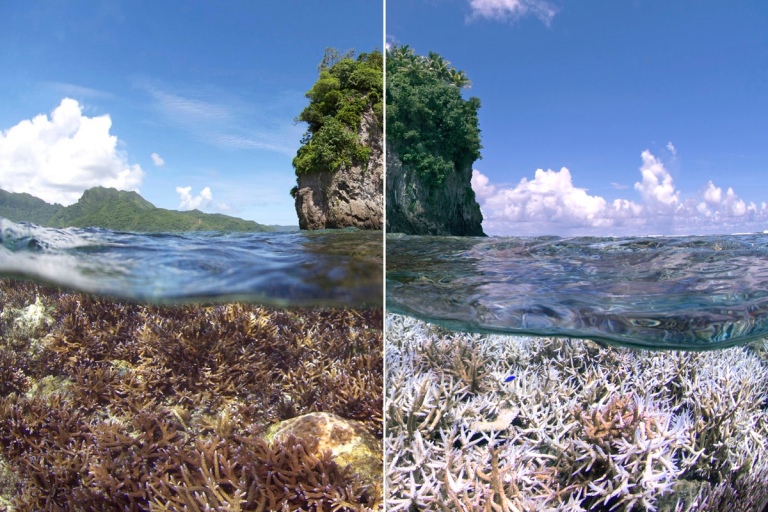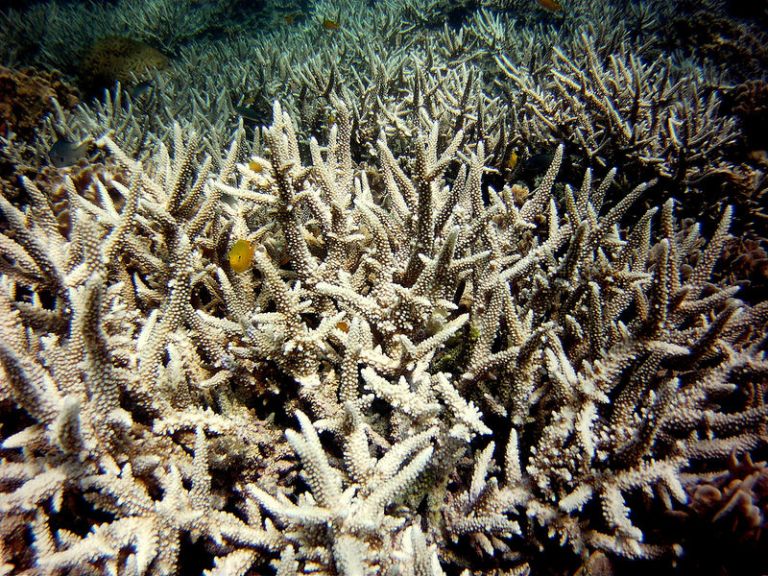Understanding the symbiotic relationship between coral and dinoflagellates to help the future of coral populations

Before and after a bleaching event.
(Photo Credit: XL Catlin Seaview Survey. Image taken from: http://www.livescience.com/52427-chilling-photos-coral-bleaching.html)
I was privileged enough to attend a seminar on Wednesday where Mathieu Pernice, a Research Associate at the University Of Technology Sydney (UTS) spoke about his current work on coral-dinoflagellate symbiosis using nanoscale secondary ion mass spectrometry (NanoSIMS). Pernice’s work highlights the importance of understanding this symbiotic relationship, in order to better understand (and possibly prevent) future coral bleaching events.
So before we get into the nitty gritty bits, let’s take a few hundred steps backwards and start from the beginning.
Back to basics:
Many plants and animals have a mutually beneficial relationship with microorganisms to help with nutrition or defense against predators and parasites (Douglas 1998). This relationship is called a symbiotic relationship (Douglas 1998). A prime example lies with one of our most beloved and colourful marine organisms; coral.
Corals are polytrophic, which means they can acquire nutrients and energy from different trophic levels by various means (Muscatine & Porter 1977). Corals are able to absorb nutrients from the surrounding water, as well as through suspension feeding of free-floating zooplankton (Muscatine & Porter 1977; Pernice et al 2015). Studies show that suspension feeding does not contribute enough to the daily energy requirement (Muscatine & Porter 1977), so where do corals procure more energy?
Coral-dinoflagellate symbiosis
Reef building corals also obtain energy through a mutual symbiosis with Symbiodinium; a genus of little photosynthetic algae called dinoflagellates (Muscatine & Porter 1977; Stat et al 2008).
These dinoflagellates fix carbon compounds through photosynthesis (the process of converting light energy into chemical energy), contributing to the general metabolic activity of the host and supporting the growth of coral reefs (Muscatine & Porter 1977; Stat et al., 2008). Dinoflagellates also source nitrogen from ammonium or nitrate, which is vital for regular cell maintenance (Yellowlees et al 2008). There are estimates of over 700 coral species sharing a symbiotic relationship with dinoflagellates (Yellowlees et al 2008) – so it must be a pretty important relationship, right?
Nitrogen
A way in which coral populations control their dinoflagellates is through limiting nitrogen, as an increase in nitrogen also leads to an increase in dinoflagellate growth rates and ability to photosynthesise (Yellowlees et al 2008). The host coral and the dinoflagellates both possess the enzyme necessary for acquiring inorganic nitrogen, which would be extremely valuable in nutrient-poor tropical areas (Yellowlees et al 2008; Pernice et al 2012).
So, who’s doing all the work?
Pernice and his colleagues were able to use the NanoSIMS to view coral-dinoflagellate symbiosis without separating the two organisms from each other, as previous studies in the past have (Pernice et al 2012). The team were then able to compare ammonium fixation between coral and dinoflagellates, as well as between different dinoflagellate clades. (Pernice et al 2012; Pernice et al 2015). They found that the dinoflagellate cells assimilated 14 to 23 times more nitrogen than the host coral cells did (Pernice et al 2012). So it seems the dinoflagellates are working a little bit harder!
Comparing the dinoflagellate clades, Pernice’s team found that type C3 assimilated more carbon and nitrogen than type D1. C3 may be more prevalent in non-stressed coral communities, yet the more temperature-tolerant D1 may be more beneficial in a stressful environment (Pernice et al 2015).
But, why do we care…?
Coral bleaching is occurring all over the world, including on the Great Barrier Reef, often causing coral death. Loss of coral communities would lead to an economical loss for tourism & recreation, and fisheries, as well as affecting coastal protection, biodiversity and carbon storage (Chen et al 2015).
Coral bleaching is takes place when the symbiotic dinoflagellates leave the coral host, turning the coral white (Brown 1997). Studies have shown that an increase in sea surface temperatures, as a result of climate warming, causes localised and mass coral bleaching (Kwiatkowski et al 2015). It is estimated that more than 90% of global coral reefs will be affected by widespread bleaching and coral degradation by 2050 (Kwiatkowski et al 2015).
If scientists can find which dinoflagellates function best in certain stressful environments, using techniques similar to Pernice and his team, they could then culture these microbes for coral populations to prevent bleaching events.
Want to learn more or want to help?
Check out the following websites:
http://www.nature.org/ourinitiatives/habitats/coralreefs/ways-to-help-coral-reefs/index.htm
http://www.barrierreef.org/about-reef/reef-qas
 Bleached coral.
Bleached coral.
(Photo by: Petchrung Sukpong (Aey). Sourced from: https://www.flickr.com/photos/aeysea)
References:
Brown, B.E. (1997) Coral bleaching: causes and consequences. Coral Reefs. 16:129-138.
Chen, P., Chen, C., Chu, L., & McCarl, B. (2015) Evaluating the economic damage of climate change on global coral reefs. Global Environmental Change. 30:12-20.
Douglas, A.E. (1998) Host benefit and the evolution of specialization in symbiosis. Heredity. 81:599-603.
Kwiatkowski, L., Cox, P., Halloran, P.R., Mumby, P.J., & Wiltshire, A.J. (2015) Coral bleaching under unconventional scenarios of climate warming and ocean acidification. Nature Climate Change. 5(8):777-781.
Muscatine, L., & Porter, J.W. (1977) Mutualistic symbioses adapted to nutrient-poor environments. BioScience. 27:454-460.
Pernice, M., Dunn, S.R., Tonk, L., Dove, S., Domart-Coulon, I., Hoppe, P., Schintlmeister, A., Wagner, M., & Meibom, A. (2015) A nanoscale secondary ion mass spectrometry study of dinoflagellate functional diversity in reef-building corals. Environmental Microbiology. 17:3570-3580.
Pernice, M., Meibom, A., Van Den Heuvel, A., Kopp, C., Domart-Coulon, I., Hoegh-Guldberg, O., & Dove, S. (2012) A single-cell view of ammonium assimilation in coral-dinoflagellate symbiosis. ISME. 6(7):1314-1424.
Stat, M., Morris, E., & Gates, R.D. (2008) Function diversity in coral: dinoflagellate symbiosis. Proc Natl Acad Sci. 105(27):9256-9261.
Yellowlees, D., Rees, T.A.V., & Leggat, W. (2008) Metabolic interatctions between algal symbionts and invertebrate hosts. Plant, Cell and Environment. 31:679-694.